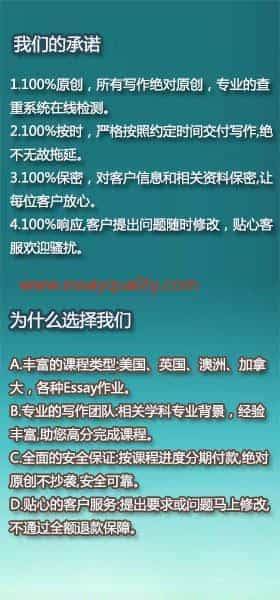Dissertation毕业代写、英国论文apa格式、mla格式代写、组成部分dissertation代写、essay代写、paper。Dissertation是每个大学生毕业最后的拦路虎,往往成为很多同学的梦魇。EssayQuality唯一网址:https://www.essayquality.com/是美国毕业论文代写第一品牌,拥有1200+北美本土毕业论文导师,100%高质量论文!100%原创无抄袭!24*7小时在线客服团队!

The literature review should ascertain and evaluate current knowledge and provide necessary background information to study. It involves a survey of existing work on the topic in order to “set the scene” in the context of current knowledge. The literature review should culminate in a series of research questions or hypotheses related to an “unknown area” which is to be explored by the student. Therefore, there is a need to classify, summarise, synthesise and comment on the existing literature (books, academic and industrial journal articles, trade magazines, newspapers, company information, refer to http://www.ukthesis.org/ygsslwdx/2592.html and electronic sources. Where there may not appear to be much existing literature to review, there are always associated areas that can be consulted, for example: theories and practices from other industries or disciplines. This approach can sometimes be used to demonstrate gaps or to apply alternative approaches or theories. In some cases, in the absence of existing literature, some preliminary primary data may have to be generated, for example by preliminary interviews.
The review should not only cover the topic itself (and associated areas) but also associated concepts. It should be a source of theoretical ideas and should establish the theoretical and conceptual context of the study. The findings from the review might necessitate modification/refinement of the initial key research question or hypothesis. Whether these are modified or not, at the culmination of the literature review, specific research questions/hypotheses to be answered/tested through the methodology should be identified.
Process
Collect information on previous research in the field, or in associated fields, together with any other background information necessary to put the study into context. In diagrammatic form, the literature review may be thought of as a triangle on its apex, i.e. begin with the broader issues and sequence the topics to focus the reader’s attention of the key issues that might impinge on the chosen topic. Collate information in sections and subsections (maybe linked to keywords) paying particular attention to similarities and differences. Highlight key information, which is especially useful to the development of the study in question. Either quote directly (with full acknowledgement including page number) or paraphrase (and acknowledge author or group of authors). Remember to comment on previous work. Do not just import quotations and string them together – effectively or otherwise!
Structure
The literature review comprises a number of sections and subsections. It is usually written in one chapter but may be divided into two or three chapters if appropriate. It is of great benefit to the reader if the structure and specific purpose of the literature review is explained at the outset.
On completion
At the end of the literature review, a summary of the key findings helps the reader to focus on the topic under study. Also, at this stage, the objectives may be refined in the light of the findings from the literature. A set of research questions or hypotheses for exploration may be included also.



